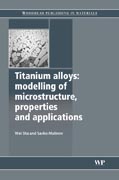
Titanium alloys: modelling of microstructure, properties and applications
Sha, Wei
Malinov, Savko
Given their growing importance in the aerospace, automotive, sports and medical sectors, modelling the microstructure and properties of titanium and its alloys is a vital part of research into the development of new applications. This is the first time a book has been dedicated to modelling techniques for titanium. Part one discusses experimental techniques such as microscopy, synchrotron radiation X-ray diffraction and differential scanning calorimetry. Part tworeviews physical modelling methods including thermodynamic modelling, the Johnson-Mehl-Avrami method, finite element modelling, the Phase-field method, thecellular automata method, crystallographic and fracture behaviour of titaniumaluminide and atomistic simulations of interfaces and dislocations relevant to TiAl. Part three covers neural network models and Part IV examines surface engineering products. These include surface nitriding: phase composition, microstructure, mechanical properties, morphology and corrosion; Nitriding: modelling of hardness profiles and kinetics; and Aluminising: fabrication of Ti coatings by mechanical alloying. With its distinguished authors, Titanium: modelling of microstructure, properties and applications is a standard reference for industry and researchers concerned with titanium modelling, as well as users oftitanium, titanium alloys and titanium aluminide in the aerospace, automotive, sports and medical implant sectors. ÍNDICE: Introduction to titanium alloys; Part 1 Experimental techniques: Microscopy; Synchrotron radiation X-ray diffraction; Differential scanning calorimetry and property measurements. Part 2 Physical models: Thermodynamic modelling; The Johnson-Mehl-Avrami method: isothermal transformation kinetics; The Johnson-Mehl-Avrami method adapted to continuous cooling; Finite element method: morphology of ƒÒ to ƒÑ phase transformation; Phase-field method: lamellar structure formation in ú^-TiAl; Cellular automata method for microstructural evolution modelling; Crystallographic and fracture behaviour of titanium aluminide; Atomistic simulations of interfaces and dislocations relevant to TiAl. Part 3 Neural network models: Neural network method; Neural network models and applications in phase transformation studies; Neural network models and applications in property studies. Part 4 Surface engineering products: Surface gas nitriding: phase composition and microstructure; Surface gas nitriding: mechanical properties, morphology, corrosion; Nitriding: modelling of hardness profilesand the kinetics; Aluminising: fabrication of Ti-Al coatings by mechanical alloying.
- ISBN: 978-1-84569-375-6
- Editorial: Woodhead
- Encuadernacion: Cartoné
- Páginas: 569
- Fecha Publicación: 30/04/2009
- Nº Volúmenes: 1
- Idioma: Inglés
